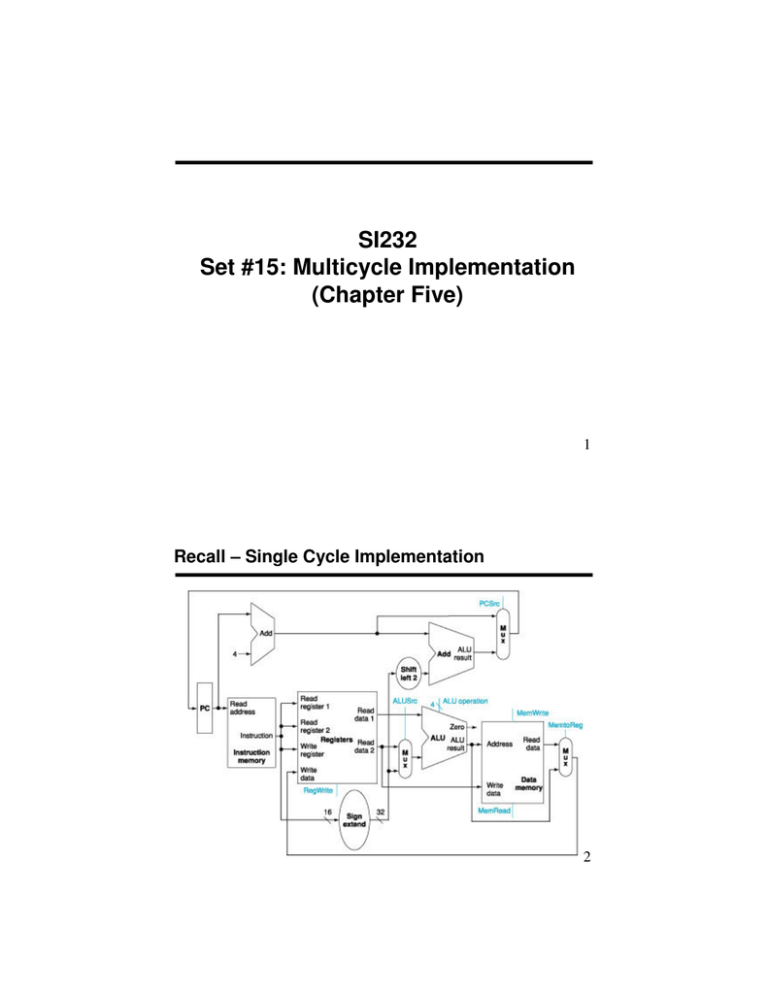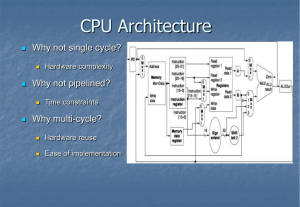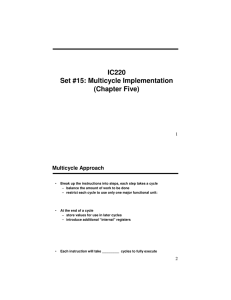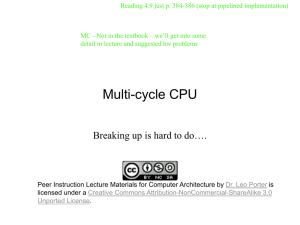SI232 Set #15: Multicycle Implementation (Chapter Five) Recall – Single Cycle Implementation
advertisement

SI232 Set #15: Multicycle Implementation (Chapter Five) 1 Recall – Single Cycle Implementation 2 Evaluation – Single Cycle Approach • Good: • Bad: 3 Multicycle Approach • Break up the instructions into steps, each step takes a cycle – balance the amount of work to be done – restrict each cycle to use only one major functional unit: • At the end of a cycle – store values for use in later cycles – introduce additional “internal” registers • Each instruction will take _________ cycles to fully execute 4 Simplified Multicycle Datapath 5 Breaking down an instruction • Steps for an R-type instruction: – IR <= Memory[PC] – A <= Reg[IR[25:21]] – B <= Reg[IR[20:16]] – ALUOut <= A op B – Reg[IR[15:11]] <= ALUOut • What did we forget? • Above notation is called RTL – Register Transfer Language 6 Example #1 – sub $t0, $s1, $s2 1. 2. 3. 4. 5. 6. IR <= Memory[PC] A <= Reg[IR[25:21]] B <= Reg[IR[20:16]] ALUOut <= A op B Reg[IR[15:11]] <= ALUOut PC <= PC + 4 7 Example #2 – lw $t0, 8($s2) 1. 2. 3. 4. 5. 6. IR <= Memory[PC] A <= Reg[IR[25:21]] ALUOut <= A + sign-extend(IR[15-0]) MDR = Memory[ALUOut] Reg[IR[20-16]] = MDR PC <= PC + 4 8 How many cycles do we need? In once cycle can do: Register read or write, memory access, ALU a.) Fill in the cycle number for each task below Cycle # Task (for R-type instruction) IR <= Memory[PC] A <= Reg[IR[25:21]] B <= Reg[IR[20:16]] ALUOut <= A op B Reg[IR[15:11]] <= ALUOut PC <= PC + 4 b.) What is the total number of cycles needed? 9 Exercise #1: How many cycles do we need? In once cycle can do: Register read or write, memory access, ALU a.) Fill in the cycle number for each task below Cycle # Task (for load instruction) IR <= Memory[PC] A <= Reg[IR[25:21]] ALUOut <= A + sign-extend(IR[15-0]) MDR = Memory[ALUOut] Reg[IR[20-16]] = MDR PC <= PC + 4 b.) What is the total number of cycles needed? 10 Exercise #2: How many cycles do we need? In once cycle can do: Register read or write, memory access, ALU a.) Fill in the cycle number for each task below Cycle # Task (for store instruction) IR <= Memory[PC] A <= Reg[IR[25-21]] B <= Reg[IR[20-16]] ALUOut <= A + sign-extend(IR[15-0]) Memory[ALUOut] = B PC <= PC + 4 b.) What is the total number of cycles needed? 11 Exercise #3: How many cycles do we need? In once cycle can do: Register read or write, memory access, ALU a.) Fill in the cycle number for each task below Cycle # Task (for branch instruction) IR <= Memory[PC] PC <= PC + 4 A <= Reg[IR[25-21]] B <= Reg[IR[20-16]] ALUOut <= PC + (sign-extend(IR[15-0]) << 2) if (A ==B) PC = ALUOut b.) What is the total number of cycles needed? 12 Exercise #4 • The branch instruction from Exercise #3 can’t really be executed given our simple datapath – why not? 13 Multicycle Implementation • Goals: – Pack as much work into each step as possible – Share steps across different instruction types • 5 Steps 1. Instruction Fetch 2. Instruction Decode and Register Fetch 3. Execution, Memory Address Computation, or Branch Completion 4. Memory Access or R-type instruction completion 5. Write-back step 14 Step 1: Instruction Fetch IR <= Memory[PC]; PC <= PC + 4; What is the advantage of updating the PC now? 15 Step 2: Instruction Decode and Register Fetch • Read registers rs and rt A <= Reg[IR[25:21]]; B <= Reg[IR[20:16]]; • Compute the branch address ALUOut <= PC + (sign-extend(IR[15:0]) << 2); • Does this depend on the instruction type? • Could it depend on the instruction type? 16 Step 3 (instruction dependent) • ALU function depends on instruction type • 1. ______________________ ALUOut <= A + sign-extend(IR[15:0]); • 2. ______________________ ALUOut <= A op B; • 3. ______________________ if (A==B) PC <= ALUOut; 17 Step 4 (R-type or memory-access) • Loads and stores access memory MDR <= Memory[ALUOut]; or Memory[ALUOut] <= B; • R-type instructions finish Reg[IR[15:11]] <= ALUOut; The write actually takes place at the end of the cycle on the edge 18 Step 5: Write-back • Reg[IR[20:16]] <= MDR; Which instruction needs this? 19 Summary: 20 Questions • How many cycles will it take to execute this code? Label: lw $t2, 0($t3) lw $t3, 4($t3) beq $t2, $t3, Label add $t5, $t2, $t3 sw $t5, 8($t3) ... #assume not taken • What is going on during the 8th cycle of execution? • In what cycle does the actual addition of $t2 and $t3 takes place? 21 Control for Multicycle Implementation 22 Control for “sub $t0, $s1, $s2” ALUSrcA = ALUSrcB = Multicycle Control • Control for single cycle implementation was ________________ , based only on the ____________ • Control for multicycle implementation will be ________________, based on the __________ and current ______________ • We’ll implement this control with state machines 24 Two Weird Things 1. For enable signals (RegWrite, MemRead, etc.) we’ll write down the signal only if it is true. For multiplexors (ALUSrcA, IorD, etc.) , we’ll always say what the value is. (unless it’s a “don’t care”) 2. Some registers are written every cycle, so no write enable control for them (MDR, ALUOut). Others have explicit control (register file, IR) Random (but useful) Refresher: ALUOp = 00 ALU adds ALUOp = 01 ALU subtracts ALUOp = 10 ALU uses function field 25 Example Control Step 1: Instruction Fetch IR <= Memory[PC] PC <= PC + 4 Example Control Step 2: Decode/Register Fetch A <= Reg[IR[25:21]]; B <= Reg[IR[20:16]]; ALUOut <= PC + (sign-extend(IR[15:0]) << 2); Exercise #1: Specify control signals needed for a load instruction Step 3: ALUOut <= A + sign-extend(IR[15:0]); Step 4: MDR = Memory[ALUOut] Step 5: Reg[IR[20-16]] = MDR Exercise #2: Specify control signals needed for a R-type instruction Step 3: ALUOut <= A op B Step 4: Reg[IR[15:11]] <= ALUOut; Exercise #3: Specify control signals needed for a branch instruction Step 3: if (A==B) PC <= ALUOut; Exercise #4: Write out steps 3-4 for a store instruction and show the control signals needed Exercise #5: Write out the step(s) (beyond 1 and 2) needed for a “jump” instruction, along with associated control. Graphical Specification of FSM • How many state bits will we need? 33 Finite State Machine for Control PCWrite Implementation: PCWriteCond IorD MemRead MemWrite IRWrite Control logic MemtoReg PCSource Outputs ALUOp ALUSrcB ALUSrcA RegWrite RegDst NS3 NS2 NS1 NS0 Instruction register opcode field S0 S1 S2 S3 Op0 Op1 Op2 Op3 Op4 Inputs Op5 • State register 34 Chapter 5 Summary • If we understand the instructions… We can build a simple processor! • If instructions take different amounts of time, multi-cycle is better • Datapath implemented using: – Combinational logic for arithmetic – State holding elements to remember bits • Control implemented using: – Combinational logic for single-cycle implementation – Finite state machine for multi-cycle implementation 35






